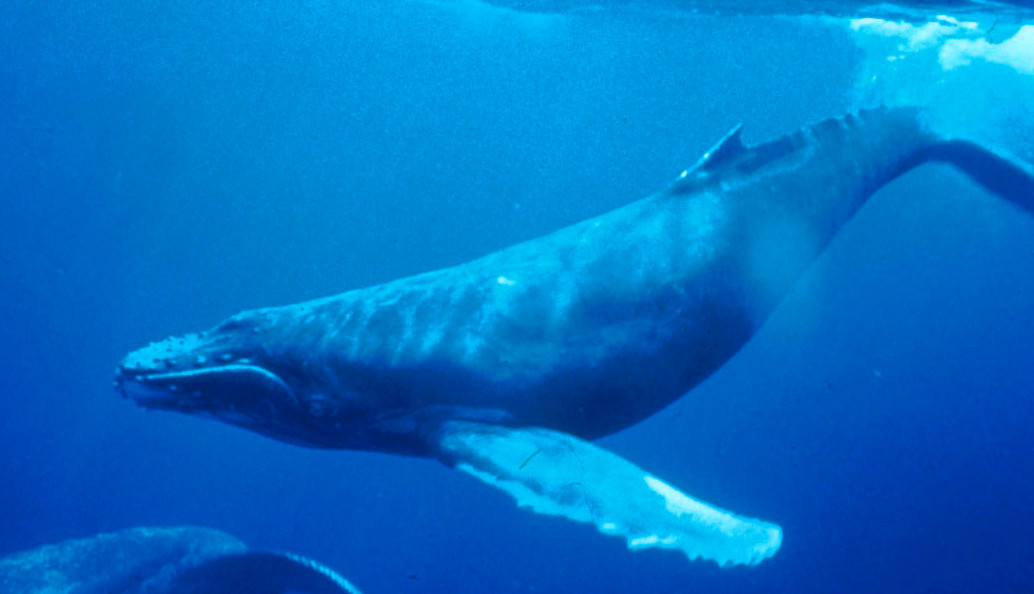Translations:AY Honors/Cetaceans/Answer Key/30/en
Baleen whales
- Family Balaenidae: right whales
The blue whale (Balaenoptera musculus)
Where found: Blue whales were abundant in nearly all the oceans on Earth until the beginning of the twentieth century. For over a century, they were hunted almost to extinction by whalers until protected by the international community in 1966. A 2002 report estimated there were 5,000 to 12,000 blue whales worldwide located in at least five groups. Before whaling, the largest population was in the Antarctic, numbering approximately 239,000 (range 202,000 to 311,000). There remain only much smaller (around 2,000) concentrations in each of the eastern North Pacific, Antarctic, and Indian Ocean groups. There are two more groups in the North Atlantic, and at least two in the Southern Hemisphere.
Description:
At 30 metres (98 ft) in length and 170 tonnes (190 short tons) or more in weight, the Blue Whale is the largest known animal ever to have existed.
Long and slender, the blue whale's body can be various shades of bluish-grey dorsally and somewhat lighter underneath. There are at least three distinct subspecies: B. m. musculus of the North Atlantic and North Pacific, B. m. intermedia of the Southern Ocean and B. m. brevicauda (also known as the pygmy blue whale) found in the Indian Ocean and South Pacific Ocean. B. m. indica, found in the Indian Ocean, may be another subspecies. As with other baleen whales, its diet consists almost exclusively of small crustaceans known as krill.- Family Balaenopteridae: rorquals
Humpback Whale (Megaptera novaeangliae)
Where found: The Humpback Whale lives in oceans and seas around the world, and is regularly sought out by whale-watchers.
Description: The Humpback is a very large whale. It is well known for its breaching (leaping out of the water), its unusually long front fins, and its complex whale song. The species feeds only in summer and lives off fat reserves during winter. It is an energetic feeder, taking krill and small schooling fish, such as herring, capelin and sand lance. It will hunt fish by direct attack or by stunning them by hitting the water with its flippers or flukes. Its most inventive feeding technique is called bubble net fishing. A group of whales will blow bubbles while swimming to create a visual barrier against fish, while one or more whales in the group make vocalizations that drive the fish against the wall. The bubble wall is then closed, encircling the fish, which are confined in an ever-tighter area. The whales then suddenly swim upwards and through the bubble net, mouths agape, swallowing thousands of fish in one gulp. This technique can involve a ring of bubbles up to 30 m (100 ft) in diameter and the cooperation of a dozen animals at once. It is one of the more spectacular acts of collaboration and cooperation among marine mammals.
- Family Eschrichtiidae: gray whale - The only species in its family.
Grey Whale (Eschrichtius robustus)
Where found: Two Pacific Ocean populations of Gray Whales exist: one small population traveling between the Sea of Okhotsk and southern Korea, and a larger one traveling between the waters off Alaska and the Baja California. A third, North Atlantic, population was hunted to extinction 300 years ago. In the fall, the California Gray Whale starts a 2–3 month, 8,000–11,000 km trip south along the west coast of the United States and Mexico. The animals travel in small groups. The destinations of the whales are the coastal waters of Baja California and the southern Gulf of California, where they breed and the young are born.
Description:
Gray Whales are covered by characteristic gray-white patterns, scars left by parasites which drop off in the cold feeding grounds. The whale feeds mainly on benthic crustaceans which it eats by turning on its side (usually the right) and scooping up the sediments from the sea floor. It is classified as a baleen whale and has a baleen, or whalebone, which acts like a sieve to capture small sea animals including amphipods taken in along with sand, water and other material. Mostly, the animal feeds in the northern waters during the summer; and opportunistically feeds during its migration trip, depending primarily on its extensive fat reserves.- Family Neobalaenidae: pygmy right whale - only one species in its family.
Pygmy right whale (Caperea marginata)
Where found: Southern Ocean
Description: The Pygmy right whale is rarely seen and little studied. Only about 25 "at sea" sightings have been recorded. It is not a right whale (misnamed) and was thought extinct until 2012. The smallest of the baleen whales, ranging between 6 metres (20 ft) and 6.5 metres (21 ft) in length and 3,000 and 3,500 kg in mass. Despite its name, the pygmy right whale may have more in common with the gray whale and rorquals than the bowhead and right whales.






